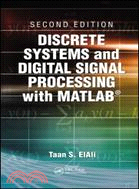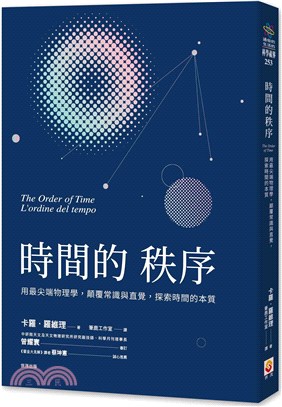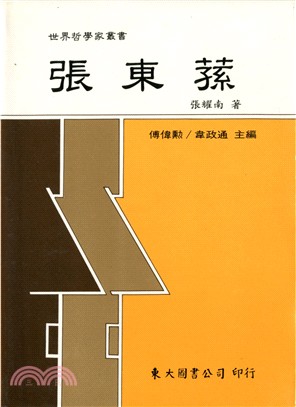定價
:NT$ 4159 元優惠價
:90 折 3743 元
若需訂購本書,請電洽客服 02-25006600[分機130、131]。
相關商品
商品簡介
作者簡介
目次
商品簡介
"Discrete linear systems and digital signal processing have been treated for years in separate publications. ElAli has skillfully combined these two subjects into a single and very useful volume. … Useful for electrical and computer engineering students and working professionals… a nice addition to the shelves of academic and public libraries.
"Summing Up: Highly Recommended."— S.T. Karris, University of California, Berkeley in CHOICE
Typically, books on linear systems combine coverage of both discrete and continuous systems all in a single volume. The result is usually a daunting mountain of information that fails to sufficiently explain either subject. With this in mind, Discrete Systems and Digital Signal Processing with MATLAB®, Second Edition responds to the need in engineering for a text that provides complete, focused coverage of discrete linear systems and associated problem solution methods.
With its simplified presentation, this book follows a logical development that builds on basic mathematical principles to cover both discrete linear systems and signal processing. The author covers all traditional topics and includes numerous examples that are solved analytically and, when applicable, numerically using the latest version of MATLAB®. In addition to the classical coverage, the author includes complete and stand-alone chapters on IIR and FIR filter design, block diagrams, state-space, and sampling and transformations, as well as a unique chapter on FFT and its many applications. The book also introduces many examples using the MATLAB data acquisition toolbox in different chapters.
Ideal either as a textbook for the required course in the electrical and computer engineering curriculum or as an updated refresher for seasoned engineers, this resource offers a wealth of examples, exercises, problems, and author insights.
"Summing Up: Highly Recommended."— S.T. Karris, University of California, Berkeley in CHOICE
Typically, books on linear systems combine coverage of both discrete and continuous systems all in a single volume. The result is usually a daunting mountain of information that fails to sufficiently explain either subject. With this in mind, Discrete Systems and Digital Signal Processing with MATLAB®, Second Edition responds to the need in engineering for a text that provides complete, focused coverage of discrete linear systems and associated problem solution methods.
With its simplified presentation, this book follows a logical development that builds on basic mathematical principles to cover both discrete linear systems and signal processing. The author covers all traditional topics and includes numerous examples that are solved analytically and, when applicable, numerically using the latest version of MATLAB®. In addition to the classical coverage, the author includes complete and stand-alone chapters on IIR and FIR filter design, block diagrams, state-space, and sampling and transformations, as well as a unique chapter on FFT and its many applications. The book also introduces many examples using the MATLAB data acquisition toolbox in different chapters.
Ideal either as a textbook for the required course in the electrical and computer engineering curriculum or as an updated refresher for seasoned engineers, this resource offers a wealth of examples, exercises, problems, and author insights.
作者簡介
Taan S. ElAli, Ph.D, has been a full professor of electrical engineering since 2002. Earning the rare honor of senior membership in the IEEE, he has worked full time for about 17 years at several academic institutions nationally and internationally in the areas of curriculum development, accreditation, teaching, research, and leadership. A former Fulbright scholar, Dr. ElAli obtained his BS in electrical engineering in 1987 from The Ohio State University, Columbus, United States, and his MS in systems engineering in 1989 from Wright State University, Dayton, Ohio, United States. He earned another MS in applied mathematics and a Ph.D in electrical engineering—with a specialization in systems, controls, and signal processing—from the University of Dayton in 1991 and 1993, respectively. Among his many awards and accomplishments, Dr. ElAli has discovered a new approach to dynamic system identification. His extensive research and interest in revolutionizing the engineering education has led to the publishing of his Innovations in Engineering Education book.
目次
Signal Representation
Introduction
Why Do We Discretize Continuous Systems?
Periodic and Nonperiodic Discrete Signals
Unit Step Discrete Signal
Impulse Discrete Signal
Ramp Discrete Signal
Real Exponential Discrete Signal
Sinusoidal Discrete Signal
Exponentially Modulated Sinusoidal Signal
Complex Periodic Discrete Signal
Shifting Operation
Representing a Discrete Signal Using Impulses
Reflection Operation
Time Scaling
Amplitude Scaling
Even and Odd Discrete Signal
Does a Discrete Signal Have a Time Constant?
Basic Operations on Discrete Signals
Energy and Power Discrete Signals
Bounded and Unbounded Discrete Signals
Some Insights: Signals in the Real World
Discrete System
Definition of a System
Input and Output
Linear Discrete Systems
Time Invariance and Discrete Signals
Systems with Memory
Causal Systems
Inverse of a System
Stable System
Convolution
Difference Equations of Physical Systems
Homogeneous Difference Equation and Its Solution
Nonhomogeneous Difference Equations and Their Solutions
Stability of Linear Discrete Systems: The Characteristic Equation
Block Diagram Representation of Linear Discrete Systems
From the Block Diagram to the Difference Equation
From the Difference Equation to the Block Diagram: A Formal Procedure
Impulse Response
Correlation
Some Insights
Fourier Series and the Fourier Transform of Discrete Signals
Introduction
Review of Complex Numbers
Fourier Series of Discrete Periodic Signals
Discrete System with Periodic Inputs: The Steady-State Response
Frequency Response of Discrete Systems
Fourier Transform of Discrete Signals
Convergence Conditions
Properties of the Fourier Transform of Discrete Signals
Parseval’s Relation and Energy Calculations
Numerical Evaluation of the Fourier Transform of Discrete Signals
Some Insights: Why Is This Fourier Transform?
z-Transform and Discrete Systems
Introduction
Bilateral z-Transform
Unilateral z-Transform
Convergence Considerations
Inverse z-Transform
Properties of the z-Transform
Representation of Transfer Functions as Block Diagrams
x(n), h(n), y(n), and the z-Transform
Solving Difference Equation Using the z-Transform
Convergence Revisited
Final-Value Theorem
Initial-Value Theorem
Some Insights: Poles and Zeroes
State-Space and Discrete Systems
Introduction
Review on Matrix Algebra
General Representation of Systems in State Space
Solution of the State-Space Equations in the z-Domain
General Solution of the State Equation in Real Time
Properties of An and Its Evaluation
Transformations for State-Space Representations
Some Insights: Poles and Stability
Block Diagrams and Review of Discrete System Representations
Introduction
Basic Block Diagram Components
Block Diagrams as Interconnected Subsystems
Controllable Canonical Form Block Diagrams with Basic Blocks
Observable Canonical Form Block Diagrams with Basic Blocks
Diagonal Form Block Diagrams with Basic Blocks
Parallel Block Diagrams with Subsystems
Series Block Diagrams with Subsystems
Block Diagram Reduction Rules
Discrete Fourier Transform and Discrete Systems
Introduction
Discrete Fourier Transform and the Finite-Duration Discrete Signals
Properties of the DFT
Relation the DFT Has with the Fourier Transform of Discrete Signals, the z-Transform, and the Continuous Fourier Transform
Numerical Computation of the DFT
Fast Fourier Transform: A Faster Way of Computing the DFT
Applications of the DFT
Some Insights
Sampling and Transformations
Need for Converting a Continuous Signal to a Discrete Signal
From the Continuous Signal to Its Binary Code Representation
From the Binary Code to the Continuous Signal
Sampling Operation
How Do We Discretize the Derivative Operation?
Discretization of the State-Space Representation
Bilinear Transformation and the Relationship between the Laplace-Domain and the z-Domain Representations
Other Transformation Methods
Some Insights
Infinite Impulse Response Filter Design
Introduction
Design Process
IIR Filter Design Using MATLAB®
Some Insights
Finite Impulse Response Digital Filters
Introduction
FIR Filter Design
Design Based on the Fourier Series: The Windowing Method
From IIR to FIR Digital Filters: An Approximation
Frequency Sampling and FIR Filter Design
FIR Digital Design Using MATLAB®
Some Insights
Bibliography
Index
Introduction
Why Do We Discretize Continuous Systems?
Periodic and Nonperiodic Discrete Signals
Unit Step Discrete Signal
Impulse Discrete Signal
Ramp Discrete Signal
Real Exponential Discrete Signal
Sinusoidal Discrete Signal
Exponentially Modulated Sinusoidal Signal
Complex Periodic Discrete Signal
Shifting Operation
Representing a Discrete Signal Using Impulses
Reflection Operation
Time Scaling
Amplitude Scaling
Even and Odd Discrete Signal
Does a Discrete Signal Have a Time Constant?
Basic Operations on Discrete Signals
Energy and Power Discrete Signals
Bounded and Unbounded Discrete Signals
Some Insights: Signals in the Real World
Discrete System
Definition of a System
Input and Output
Linear Discrete Systems
Time Invariance and Discrete Signals
Systems with Memory
Causal Systems
Inverse of a System
Stable System
Convolution
Difference Equations of Physical Systems
Homogeneous Difference Equation and Its Solution
Nonhomogeneous Difference Equations and Their Solutions
Stability of Linear Discrete Systems: The Characteristic Equation
Block Diagram Representation of Linear Discrete Systems
From the Block Diagram to the Difference Equation
From the Difference Equation to the Block Diagram: A Formal Procedure
Impulse Response
Correlation
Some Insights
Fourier Series and the Fourier Transform of Discrete Signals
Introduction
Review of Complex Numbers
Fourier Series of Discrete Periodic Signals
Discrete System with Periodic Inputs: The Steady-State Response
Frequency Response of Discrete Systems
Fourier Transform of Discrete Signals
Convergence Conditions
Properties of the Fourier Transform of Discrete Signals
Parseval’s Relation and Energy Calculations
Numerical Evaluation of the Fourier Transform of Discrete Signals
Some Insights: Why Is This Fourier Transform?
z-Transform and Discrete Systems
Introduction
Bilateral z-Transform
Unilateral z-Transform
Convergence Considerations
Inverse z-Transform
Properties of the z-Transform
Representation of Transfer Functions as Block Diagrams
x(n), h(n), y(n), and the z-Transform
Solving Difference Equation Using the z-Transform
Convergence Revisited
Final-Value Theorem
Initial-Value Theorem
Some Insights: Poles and Zeroes
State-Space and Discrete Systems
Introduction
Review on Matrix Algebra
General Representation of Systems in State Space
Solution of the State-Space Equations in the z-Domain
General Solution of the State Equation in Real Time
Properties of An and Its Evaluation
Transformations for State-Space Representations
Some Insights: Poles and Stability
Block Diagrams and Review of Discrete System Representations
Introduction
Basic Block Diagram Components
Block Diagrams as Interconnected Subsystems
Controllable Canonical Form Block Diagrams with Basic Blocks
Observable Canonical Form Block Diagrams with Basic Blocks
Diagonal Form Block Diagrams with Basic Blocks
Parallel Block Diagrams with Subsystems
Series Block Diagrams with Subsystems
Block Diagram Reduction Rules
Discrete Fourier Transform and Discrete Systems
Introduction
Discrete Fourier Transform and the Finite-Duration Discrete Signals
Properties of the DFT
Relation the DFT Has with the Fourier Transform of Discrete Signals, the z-Transform, and the Continuous Fourier Transform
Numerical Computation of the DFT
Fast Fourier Transform: A Faster Way of Computing the DFT
Applications of the DFT
Some Insights
Sampling and Transformations
Need for Converting a Continuous Signal to a Discrete Signal
From the Continuous Signal to Its Binary Code Representation
From the Binary Code to the Continuous Signal
Sampling Operation
How Do We Discretize the Derivative Operation?
Discretization of the State-Space Representation
Bilinear Transformation and the Relationship between the Laplace-Domain and the z-Domain Representations
Other Transformation Methods
Some Insights
Infinite Impulse Response Filter Design
Introduction
Design Process
IIR Filter Design Using MATLAB®
Some Insights
Finite Impulse Response Digital Filters
Introduction
FIR Filter Design
Design Based on the Fourier Series: The Windowing Method
From IIR to FIR Digital Filters: An Approximation
Frequency Sampling and FIR Filter Design
FIR Digital Design Using MATLAB®
Some Insights
Bibliography
Index
主題書展
更多
主題書展
更多書展本週66折
您曾經瀏覽過的商品
購物須知
外文書商品之書封,為出版社提供之樣本。實際出貨商品,以出版社所提供之現有版本為主。部份書籍,因出版社供應狀況特殊,匯率將依實際狀況做調整。
無庫存之商品,在您完成訂單程序之後,將以空運的方式為你下單調貨。為了縮短等待的時間,建議您將外文書與其他商品分開下單,以獲得最快的取貨速度,平均調貨時間為1~2個月。
為了保護您的權益,「三民網路書店」提供會員七日商品鑑賞期(收到商品為起始日)。
若要辦理退貨,請在商品鑑賞期內寄回,且商品必須是全新狀態與完整包裝(商品、附件、發票、隨貨贈品等)否則恕不接受退貨。
























